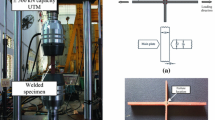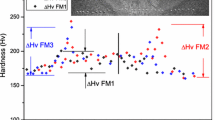Abstract
The structural integrity of the fillet-welded joint with large gap sizes made by semi-automatic CO2 gas shielded welding is investigated to suggest for the improvement of construction quality standards. An allowable limit on the gap size of welded joints is specified in many construction quality standards based on experimental and empirical results from the welded joints made by manual metal arc welding. Mechanical tests such as hardness, tensile, bending and fatigue were performed to confirm the welded specimen’s quality. Macro observation and dye penetrants inspection were performed on the welded specimen face and weld toe area to verify if any defects are present. Obtained S–N curves from experimental results for the welded specimen with large gap present higher performance compared to the fatigue design S–N curves proposed by the International Institute of Welding (IIW) and UK-HSE.





























Similar content being viewed by others
References
IACS No. 47—Rev. 5 (2010) Shipbuilding repair quality standard, International Association of Classification Societies
JSQS (2010) Japan Shipbuilding and Quality Standard—Hull Part, Japan Society of Naval Architects and Ocean Engineers
Miki C, Tateishi K, Fan HD, Tanaka M (1993) Fatigue strengths of fillet-welded joints containing root discontinuities. Int J Fatigue 15(2):133–140
Hobbacher H (2009) Recommendations for fatigue design of welded joints and components, IIW doc.1823-07, Welding Research Council Bulletin 520, New York
Japanese society of steel construction—JSSC (2012) Fatigue design recommendations for steel structures (in Japanese)
Health and Safety Executive (UK-HSE) (2012) Status of technical guidance and information on design, construction and operation of offshore installations
Lee CH, Chang KH, Jang GC, Lee CY (2009) Effect of weld geometry on the fatigue life of non-load-carrying filletwelded cruciform joints. Eng Fail Anal 16:849–855
Pang HLJ (1993) Analysis of weld toe profiles and weld toe cracks. Int J Fatigue 15(1):31–36
ClassNK (2013) Rules for survey and construction of steel ships, Part M—Welding
Technical Report ISO/TR 14345:2012, Fatigue—Fatigue testing of welded components—guidance, ISO and IIW
JSME Standard 002 (1984) Standard Method of Statistical Fatigue Testing
Ferreira JAM, Branco CAM (1989) Influence of the radius curvature at the weld toe in the fatigue strength of fillet welded joints. Int J Fatigue 11(1):29–36
Okayasu M, Ohkura Y, Sakamoto T, Takeuchi S, Ohfuji H, Shiraishi T (2013) Mechanical properties of SPCC low carbon steel joints prepared by metal inert gas welding. Mater Sci Eng, A 560:643–652
Nguyen TN, Wahab MA (1995) A theoretical study of the effect of weld geometry parameters on fatigue crack propagation life. Eng Fract Mech 51(1):1–18
Kainuma S, Mori T (2006) A fatigue strength evaluation method for non-load carrying fillet welded cruciform joints. Int J Fatigue 28:864–872
Nykanen T, Marquis G, Bjork T (2007) Fatigue analysis of non-load-carrying fillet welded cruciform joints. Eng Fract Mech 74:399–415
Acknowledgments
The first author gratefully acknowledged the Malaysian Government (Public Service Department), especially Department of Occupational Safety and Health Malaysia for their supports through scholarships provided. The authors also acknowledge Mr. Koji Murakami, senior technical staff of Kyushu University for the support during experimental work.
Author information
Authors and Affiliations
Corresponding author
About this article
Cite this article
Abdullah, E., Gotoh, K. & Deguchi, J. Comprehensive study of structural integrity of non-load-carrying fillet-welded joint effect with large gap size. J Mar Sci Technol 20, 752–764 (2015). https://doi.org/10.1007/s00773-015-0328-z
Received:
Accepted:
Published:
Issue Date:
DOI: https://doi.org/10.1007/s00773-015-0328-z




